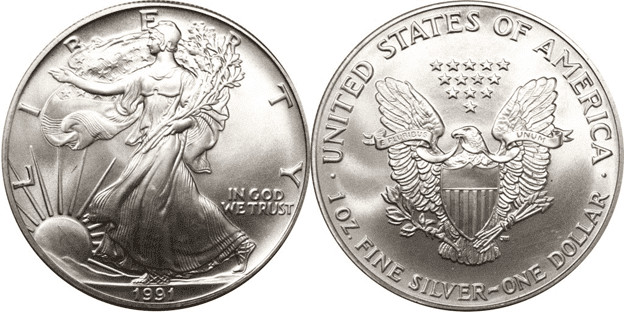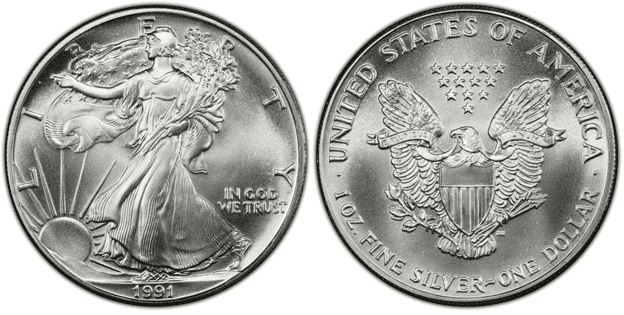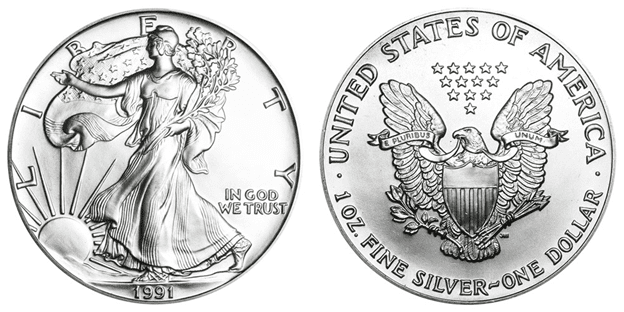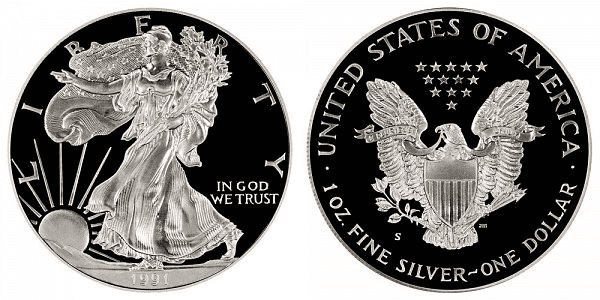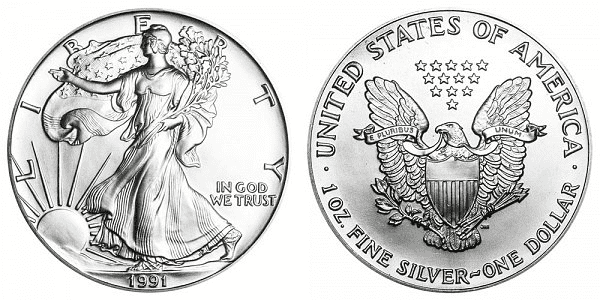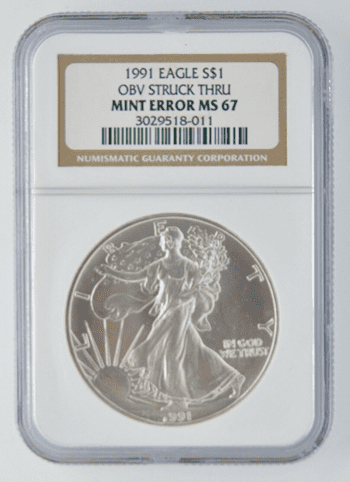What Is the 1991 Silver Dollar Made Of?
The 1991 silver dollar is 99.93% silver with 0.07% copper. It has a face value of $1 but it has a higher melt value, which is around $20.
Here are the specifications of the 1991 silver dollar coin:
- Mass: 1.00 troy oz (31.103 g)
- Diameter: 1.598 in (40.6 mm)
- Thickness: 0.1173 in (2.98 mm)
- Edge: Reeded
- Date of first release: November 24, 1986
The obverse of the 1991 silver dollar was designed by Adolph A. Weinman while the reverse was designed by John Mercanti.

photo source: Coin HelpU
The obverse features the beautiful Walking Liberty image. On her hand, she carries branches of olive. At her back is a flowing flag with stars on it. In front of her feet is a sun. The inscription includes the following:
- LIBERTY
- IN GOD WE TRUST
- 1991
The reverse looks like the Presidential Seal but with a few differences. The Heraldic Eagle has a banner on its beak, which says, “E PLURIBUS UNUM” (out of many, one). In front of the eagle is a shield with thirteen stripes, symbolizing the first 13 states. There are also 13 stars on top of the eagle. The eagle carries with it an olive branch and arrows.
The inscription includes the following:
- UNITED STATES OF AMERICA
- 1 OZ. FINE SILVER
- ONE DOLLAR
- Designer’s initials
- Mint mark (if present)
The American Silver Eagle coin is the silver bullion coin of the United States. The coin was first issued on November 24, 1986, through the Liberty Coin Act, indicated in the Title II of Public Law 99-61. The United States Mint guarantees the weight, content, and purity of the coin.
There are different types of 1991 silver dollar coins produced in the San Francisco Mint, Philadelphia Mint, and West Point Mint. The 1991 silver dollar coins are considered a bullion version.
Starting in 2010, the US Mint also created silver-proof coins. From 2006 to 2008 and 2011 up to the present, uncirculated silver dollar coins are also made for coin collectors.
1991 Silver Dollar Varieties
The 1991 silver dollar comes in different varieties. They differ basically on where they are struck and whether they are proof or not. Aside from that, you’ll see different mint marks or sometimes, no mint marks at all. There are times as well that the silver dollar was made with errors, which gives rise to a different variety.
Here are some of the most common varieties of the 1991 silver dollar:
1991 $1 Silver Eagle (Regular Strike)
Year of minting: 1991
Mint Mark: No mint mark
Place of minting: Philadelphia
Quantity produced: 7,191,066
Face Value: $1.00 (twenty-five cent)
Price: $20 to $100 dollars (or more)
Mass: 31.103 g
Edge: Reeded
Designer: Adolph Weinman (obverse) and John Mercanti (reverse)
Composition: 99.93% Silver and 0.007% Copper
Diameter: 40.6 mm
Thickness: 1.75 millimeters

photo source: PCGS
The regular struck 1991 silver dollar was made in the Philadelphia Mint. It is the most abundant 1991 silver dollar variety. The Philadelphia Mint produced more than 7.1 million of these coins. You can sell this coin for $20 to $100 or more, depending on the condition and rarity of your coin.
1991 S American Silver Eagle Bullion Coins
Year of minting: 1991
Mint Mark: No mint mark
Place of minting: San Francisco
Quantity produced: 3,019,066
Face Value: $1.00 (twenty-five cent)
Price: $20 to $28 dollars (or more)
Mass: 31.103 g
Edge: Reeded
Designer: Adolph Weinman (obverse) and John Mercanti (reverse)
Composition: 99.93% Silver and 0.007% Copper
Diameter: 40.6 mm
Thickness: 1.75 millimeters

photo source: PCGS
Normally, San Francisco coins receive a mint mark of S. However, for the 1991 S silver dollar coin, it doesn’t have the S mint mark. At the end of 1991, there were more than 3 million of these coins produced. Normal pricing ranges from $20 to $28 dollars.
1991 S American Silver Eagle Bullion Coins (Proof)
Year of minting: 1991
Mint Mark: S
Place of minting: San Francisco
Quantity produced: 511,924
Face Value: $1.00 (twenty-five cent)
Price: $20 to $60 dollars (or more)
Mass: 31.103 g
Edge: Reeded
Designer: Adolph Weinman (obverse) and John Mercanti (reverse)
Composition: 99.93% Silver and 0.007% Copper
Diameter: 40.6 mm
Thickness: 1.75 millimeters

photo source: PCGS
The San Francisco Mint also produced proof coins in the same year of 1991. Since these are proof coins, the Mint was only able to produce 511,924 coins. The reason is that proof coins are more difficult and time-consuming to produce.
As this might be the case, 1991 silver dollar-proof coins are more detailed, beautiful, and shinier. If you have one of these or you wish to buy one, expect that the usual pricing is about $20 to $60 dollars.
1991 W American Silver Eagle Bullion Coins
Year of minting: 1991
Mint Mark: No mint mark
Place of minting: West Point
Quantity produced: 4,172,000
Face Value: $1.00 (twenty-five cent)
Price: $20 to $29 dollars (or more)
Mass: 31.103 g
Edge: Reeded
Designer: Adolph Weinman (obverse) and John Mercanti (reverse)
Composition: 99.93% Silver and 0.007% Copper
Diameter: 40.6 mm
Thickness: 1.75 millimeters

photo source: PCGS
To create more bullion silver coins in 1991, the West Point Mint also helped in the process. At the end of that year, more than four million of these coins were struck. The price of these coins is about $20 to $29 dollars.
List of 1991 Silver Dollar Errors
The 1991 silver dollar errors may happen due to problems in the dies, planchets, and other minting equipment. Aside from that, there are also errors due to human error.
Here’s an example of a 1991 silver dollar with an obverse struck-through error:

photo source: eBay
During the minting process, a foreign material came between the die and planchet. The die “strikes through” the foreign material. As a result, you can find a trace of that foreign material, which can be dust, grease, or other small particles.
How Much Is the 1991 Silver Dollar Worth Today?
The 1991 silver dollar is priced around $20 to $200. It can be higher or it can be lower. It depends on the rarity and condition of the coin. While the nominal face value of the silver dollar is one dollar, it has a higher melt value, which can be around $19-$20. The value goes up and down, depending on the valuation of silver in the market.
To give you an example, here is a table to help you compare 1991 silver dollar prices:
| Coin | Condition | Grade | Mintage | Value |
| 1991 $1 Silver Eagle (Regular Strike) | Circulated/mint | Not graded | 7,191,066 | $20-$100 |
| 1990 Silver Eagle Dollar | Uncirculated/mint | MS-68 | 7,191,066 | $25-$82 |
| 1990 Silver Eagle Dollar | Uncirculated/mint | MS-69 | 7,191,066 | $23-$228 |
| 1990 Silver Eagle Dollar | Uncirculated/mint | MS-70 | 7,191,066 | $900-$2,040 |
| 1991 S American Silver Eagle Bullion Coins | Circulated/proof | MS-65 | 3,019,066 | $28 (or more) |
| 1991 S American Silver Eagle Bullion Coins (Proof) | Uncirculated/proof | PR-65 | 695,510 | $60 (or more) |
| 1991 W American Silver Eagle Bullion Coins (No Mint Mark) | Uncirculated/proof | MS-65 | 695,510 | $25 (or more)
|
How Does The Grading System Work?
The Sheldon Scale is used by numismatists to provide a numerical value to coins. The Sheldon Scale goes from poor (P-1) to perfect mint state (P-1) (MS-70). Coins were originally evaluated using words to reflect their condition (Good, Fair, Excellent, Etc.). Unfortunately, coin collectors and dealers had different ideas about what each of these terms represent.
Professional numismatists joined together in the 1970s and established CoinGrading standards. These numismatists now assign grades at key places on the seventy-point scale, using the most regularly utilized numeric points in conjunction with the original adjective grade. The following are the most common coin grades:
-
-
- (P-1) Poor – Indistinguishable and probably damaged; if used, must have a date and mintmark; otherwise, rather battered.
- (FR-2) Fair – Nearly smooth, but without the damage that a coin graded Poor often possesses. The coin must have enough detail to be identified.
- (G-4) Fair – Inscriptions have merged into the rims in some areas, and important elements have been mostly erased.
- (VG-8) Very Good- A little weathered, but all of the primary design elements are visible, albeit faintly. There is little if any, central detail left.
- (F-12) Good – The item is very worn, yet the wear is even, and the overall design details stand out clearly. Rims are almost completely isolated from the field.
- (VF-20) Very Fine – Moderately weathered, with some finer features still visible. The motto or all letters of LIBERTY are readable. Both sides of the coin have entire rims that are separated from the field.
- (EF-40) Extremely Fine – Gently used; all gadgets are visible, and the most important ones are bold. The finer details are bold and clear, however, light wear may be seen.
- (AU-50) Uncirculated – Slight evidence of wear on the coin’s design’s high points; may have contact marks; eye appeal should be adequate.
- (AU-58) Uncirculated Choice – Slight traces of wear, no severe contact marks, almost full mint shine, and great eye appeal.
- (MS-60) Mint State Basal – Strictly uncirculated; no indication of wear on the coin’s highest points, but an unsightly coin with reduced luster, visible contact marks, hairlines, and other flaws.
- (MS-63) Mint State Acceptable – Uncirculated, but with contact scratches and nicks, little reduced shine, but otherwise appealing appearance. The strike is weak to average.
- (MS-65) Mint State Choice – Uncirculated with great mint shine, very little contact blemishes, and exceptional eye appeal. The strike is unusually severe.
- (MS-68) Mint State Premium Quality – Uncirculated with superb luster, no obvious contact marks to the naked eye, and exceptional eye appeal. The strike is quick and appealing.
- (MS-69) Almost Perfect Mint State – Uncirculated with perfect brilliance, a sharp and appealing strike, and extremely good eye appeal. A near-perfect coin with minor imperfections in the planchet, strike, and contact markings (seen only under 8x magnification).
- (MS-70) Mint State Perfect – Under 8x magnification, there are no tiny imperfections discernible; the strike is crisp, and the coin is perfectly centered on a beautiful planchet. Rarely seen on a coin, this coin is bright and whole, with original luster and exceptional eye appeal.
-
Where to Buy or Sell the 1991 Silver Dollar?
There are different places where you can buy or sell 1991 silver dollar coins. Here are some of them:
- Coin shops
- Antique shops
- eBay
- Amazon
- Facebook Marketplace
- Specialized websites such as Coin Tracker, USA Coin Book, and others
- Coin grading service providers
- Auction houses
Be sure to buy from a reputable and trusted seller. There are a lot of scammers out there. So, be careful with whom you transact.
Also, if you are a seller, you can first let an expert grader check your coin. This way, you know the value of your coin and you don’t sell it at a cheaper price.
FAQs
How do I know if my silver dollar is worth money?
To know the value of your silver coin, you can get in touch with a professional coin grader. From there, they will tell you whether your silver dollar is worth the money or not. Also, you can do your own research.
Where is the mint mark on a 1991 silver dollar?
The mint mark, if present, is found on the 1991 silver dollar’s reverse side. It is located near the left talon of the eagle.
Are there Mount Rushmore anniversary coins?
On February 15, 1991, the US Mint released the half-dollar Mount Rushmore coin as part of the 50th-anniversary celebration of the completion of Mount Rushmore. The coin was first introduced to the public in Ford’s theatre, in South Dakota.

